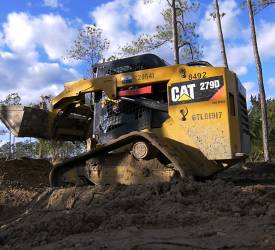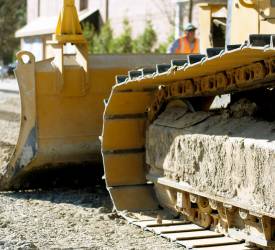ConstructionSite Work
Sitework Refers To The Scope Of Work Relating To The Project Exterior, And That Is Not Part Of A Building's Physical Structure. It Includes Clearing, Soil Erosion Control, Grading, Excavation, Sewer Systems Installation, Asphalt Paving, And Other Utilities.
Sitework Is A Preliminary Task Performed On A Site Before The Construction Begins. But Technically, It Is Any Part Of The Construction Project That Does Not Involve The Actual Building. In Short, It Involves The Preparation Of The Area You Want To Construct A Physical Structure. Site Work Helps Keep Your Project Moving Seamlessly. If You Have A Construction Project In Charleston, SC, O.L. Thompson Construction (OLTC) Is A Reputable Construction Company With Experienced Experts In Site Work.


Surveying
The first step to all ground-up projects is surveying to set the lay of the land. A surveyor positions, measure, create an accurate topographical map, establish locations for foundations and map out boundaries in this process.




Clearing
The contractor clears the site to get rid of shrubs, trees, and bushes. Regulatory and environmental concerns may dictate clearing and grubbing processes based on the quantity and types of vegetation on the site. Areas with enormous trees may consume more time and resources, since they must be cut down in a thickly wooded location. Any necessary demolitions can also occur in this stage.




Erosion Control And Shoring
General contractors can install erosion control after mapping out the land. A construction site may experience problems such as erosion, collapse, or weathering as the construction continues. Therefore, erosion control and shoring are essential to prevent that from happening. Failure to have that in place makes the entire site unsafe for workers and equipment.




Stabilizing
Moving soil during the excavation process can make it soft and less stable. When the soil is less stable, it means the particles are large. Stabilization eliminates air pockets or holes that could be present below the earth's surface. Subgrade stabilization is also essential to eliminate cracks and other structural problems in your Charleston, SC site.
It also stabilizes the soil below the topsoil to prevent shifting or collapse. Stabilization is a crucial aspect of site work that helps ensure project integrity. A heavy roller or a vibration compactor can help compact the soil.




Excavating
The excavation process removes excess dirt and rocks from the construction site. Since this process can be time-consuming at your Charleston, SC job site, it may frequently necessitate employing large machinery to perform the task properly.
Fortunately, OLTC has experienced excavators with the skills and knowledge necessary for this tough task. They excavate the section to remove surplus soil which could entail chopping down the hillsides and creating a way for the new structure. They can also dig a hole to accommodate a new septic system. The surplus soil can fill the low locations on the site. Also known as grading, this process prevents problems such as foundation damage, basement flooding, and erosion in residential or commercial buildings.




Leveling
Once the soil is in the proper location, it is time for leveling. The contractor employs a skid loader or a backhoe to move the dirt to the appropriate spots. After that, they use a leveling device to maintain a uniform level across the board.
Creating a graded slope is a crucial aspect of leveling. That means that water won't flow towards the structure but away from it. Smoothing out of dirt helps ensure the slope does not become too shallow or steep.




Site Utilities
Site utilities help bring water, fire mains, electric, gas, sewer, and storm to the building. They come with various materials, including metal, thermoplastic pipes, concrete, or cast iron.
The process begins with excavating and laying down the pipes on top of the bedding material. Backfilling and leveling to grade can occur after inspection.




Concrete
Concrete can either be pre-cast or cast-in-place type. The cast-in-place type involves pouring concrete into forms to create patios, sidewalks, foundations, foundation walls, etc. On the other hand, pre-cast concrete is in a reusable form that is cured and in a controlled environment before taking it to the installation site.
Although pre-cast concrete is not suitable for all situations, it offers the general contractors more control over material quality and final product. Cast-in-place concrete is great in insulation, versatility, strength, and construction speed.




Asphalt Paving
Paving as part of the site work projects begins before construction. It involves pouring concrete or asphalt over sections of the construction site. Paving offers a good surface that allows construction during bad weather, helps control erosion, and provides a solid surface for storing materials.
Asphalt paving is appealing, long-lasting, and quick to install. People may take driveways for granted without considering its benefits if it consists of the right material. A well-implemented asphalt is excellent for overall appearance, driveability, environment, and budget.
This paving consists of sand, aggregate, liquid asphalt, and additives. Liquid asphalt (bitumen) is a sticky substance that binds materials in these pavements. Before applying asphalt paving, the contractor must have completed the aforementioned preparations, including clearing, excavation, and ground compaction. That is unless the contractor is laying it over existing asphalt.




Water Systems And Drainage
Installation of a water system helps bring in clean water for use in the building once constructed while pumping out the wastewater. Storm drainage is a crucial part of the site work process that draws a distinct line between beautifully accomplished structures and poorly made products. Therefore, general contractors are responsible for ensuring pooling rainwater does not erode your building by providing the system. Contractors should also install septic tanks and filtration systems where required.
Final thought
It is easy to concentrate on constructing the new building while overlooking the project’s site work. However, the work done on the site before actual construction is just as critical, if not more so, than the new structure. That is why you must consider working with experienced general contractors to carry out site work on your Charleston, SC project for guaranteed structural quality.













